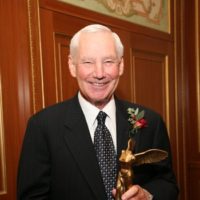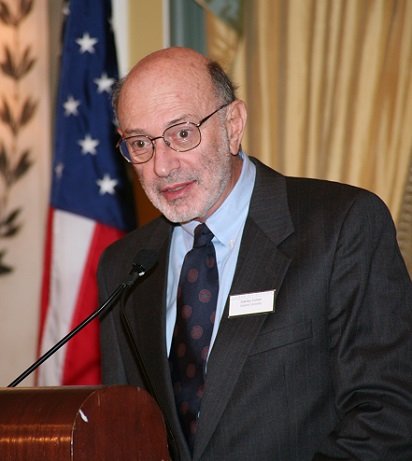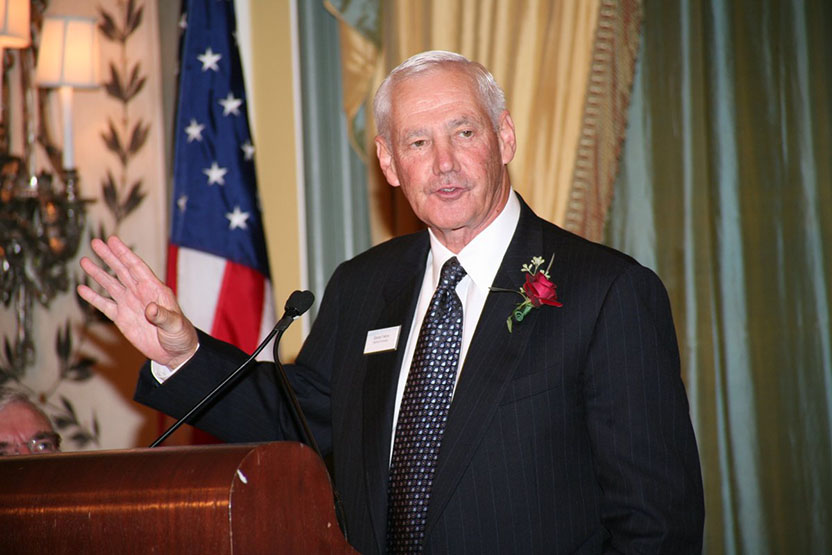As an undergraduate, Falkow trained in a hospital microbiology laboratory. There, he learned how to discriminate between bacteria that live peacefully in our bodies and those that cause illness. Biochemical tests pinpointed features that distinguish the microbes from one another, but Falkow’s instincts told him that additional traits dictated whether an organism would stir trouble. This hunch sparked questions that have captivated him ever since: Why do some bacteria, but not their close relatives, live harmlessly within us? What makes a pathogen a pathogen? This early immersion in medical microbiology forever tethered Falkow to the clinical world and led him into his first major research finding.
In 1959, researchers isolated from a patient with typhoid fever a version of its causative agent — Salmonella typhi — that could use the sugar lactose as food. This characteristic violated one of the conventional properties of S. typhi. Falkow was intrigued. It was as if he had seen a lion with zebra’s stripes. Furthermore, this S. typhi could transfer to other bacteria its ability to derive energy from lactose (lac+). The S. typhi observation grabbed Falkow because the germ had picked up its lac+ attribute in nature.
At the time, researchers had detailed some mechanisms by which bacteria pass characteristics to one another, but the lac+ transfer represented a different method from those that had been studied. Therefore, no one had established the molecular nature of the lac+ element.
By exploiting the fact that bacterial species contain DNA of characteristic densities and the ability of the S. typhi strain to transfer its lac+ element to distantly related bacteria, Falkow and the late Julius Marmur (Brandeis University) established in 1961 that the lac+ element was made of DNA and, crucially, that it remains distinct from the chromosome. Such elements are now called plasmids. In addition to establishing that plasmids exist, Falkow’s method broke open the ability to separate them from chromosomes, an advance that would have a dramatic impact on the entire future of molecular biology.
In this same set of experiments, Falkow showed that another ill-defined genetic element — R factor — was also a piece of DNA that resided outside the chromosome. This finding held extraordinary medical importance.
In the 1950s, clinicians had begun to notice that germs could acquire resistance to multiple antibiotics during transit through a patient’s intestinal tract, and by 1962, this phenomenon had become a global health problem. Falkow’s discovery that R factors are plasmids, like the lac+ element, provided an explanation for the observations: Each R factor carried genes that encode resistance to one or more antibiotics, and destructive microbes can pick them up from harmless bacteria that dwell in the body. Falkow subsequently found that the antibiotic resistance genes reside on genetic elements that can hop from one piece of DNA to another. Several other laboratories simultaneously detected these so-called transposable elements — or transposons. Not only could bacteria pass R factors to one another, but the antibiotic genes on these R factors could jump from plasmid to plasmid or from plasmid to chromosome.
In addition to its implications for public health and understanding the basic biology by which bacteria transmit traits to one another, Falkow’s work on lac+ and R factors helped lay the groundwork for one of the first recombinant DNA experiments, in which Herbert Boyer (University of California, San Francisco) and Stanley Cohen (Stanford University) created a hybrid molecule composed of two completely unrelated parent DNAs, one of which Falkow provided. The resulting plasmid duplicated inside a bacterial cell and its descendants. Suddenly it was possible to isolate a gene of interest from any organism, manipulate it, and re-introduce it into living cells.
Opening the bacterial toolbox
The ability to insert single genes into a bacterium of choice presented a new experimental playground for Falkow. This method provided a way to discern the function of any particular gene and thus, he could tease apart individual threads of pathogenesis.
In 1976, Falkow and his student Magdalene So used the new recombinant DNA technology to isolate the heat-stable toxin gene from a type of Escherichia coli that causes diarrhea, thus ‘cloning’ the first gene involved in bacterial virulence. He subsequently pinned down genes that encode many functions — other toxins, molecules that deflect or undermine immune attack, proteins that attach bacteria to their target host cells, and regulators that govern the activity of other virulence genes. He began increasingly to think about virulence factors not as elements that define disease-causing bacteria in the laboratory, but as elements that help bacteria in their fundamental mission to duplicate.
One cloning experiment in particular changed the course of Falkow’s work and the field. He and his postdoctoral fellow Ralph Isberg tracked down a molecule that could confer upon a normally non-invasive type of E. coli the ability to enter mammalian cells in culture dishes. When Falkow looked under the microscope at this event, he noticed that the host cells pucker at the point of bacterial contact and slurp up the E. coli carrying the invasion protein. The molecule seemed to be triggering a normal host process by which the cells usually ingest a useful particle from their surroundings.
Falkow knew then that the next frontier in studying disease-causing bacteria would involve probing interactions between host cells and bacteria rather than bacteria alone in petri dishes. His work in this arena with postdoctoral fellow B. Brett Finlay spurred a profound new approach in the field, a discipline that is now called cellular microbiology. Researchers have since found that bacteria harness multiple host talents to perform tasks that are crucial for the microbes’ duplication and spread. This ability to co-opt host cells allows the germs to gain entry, escape from compartments that would otherwise kill them, hijack molecules and direct them to propel the bacteria into adjacent cells, trigger cell-suicide mechanisms that allow the bacteria to enter their preferred areas of the body, and so on.
Since the beginning of his career, Falkow has forged new tools with which to study infectious disease. In addition to introducing the use of recombinant DNA technology in the field, he initiated the discipline of molecular epidemiology and developed a method for identifying disease-causing bacteria that cannot be grown (and thus scrutinized by conventional means) in the laboratory; he was one of the first investigators to use DNA microarrays, deploying these devices to probe pathogen and host genes that play a role in infection; and he pioneered fluorescent imaging as a means to track microbes inside host cells.
Falkow has applied his knowledge and foresight to benefit the public. For example, he predicted the spread of clinical antibiotic resistance and, in the late 1970s, urged the US Food and Drug Administration to remove antibiotics from animal feed. At the advent of the recombinant DNA era, Falkow’s views on the risks of placing new genes into bacteria were widely sought and proved highly influential in developing the guidelines that govern such experiments.
Falkow’s contributions to bacterial pathogenesis extend far beyond the walls of his own laboratory. An enormous number of researchers in the field, including many of its most illustrious members, have worked with him and he has influenced and inspired numerous other eminent investigators. Falkow is known for his wit and irreverence as well as an unmatched intuition about his miniscule study subjects. He possesses an unusual ability to ‘get inside’ a bacterium and think about the world from the microbial point of view, a perspective that he instills in all audiences. Universally considered the father of modern molecular pathogenesis, he has earned from his trainees and colleagues overflowing respect and affection.
by Evelyn Strauss
Key publications of Stanley Falkow
Falkow, S., Citarella, R.V., Wohlhieter, J.A., and Watanabe, T. (1966). The molecular nature of R-factors. J. Mol. Biol. 17, 110-116.
Heffron, F., Bedinger, P., Champoux, J.J., and Falkow, S. (1977). Deletions affecting the transposition of an antibiotic resistance gene. Proc. Natl. Acad. Sci. USA. 74, 702-706.
Dallas, W. and Falkow, S. (1979). The molecular nature of heat-labile enterotoxin (LT) of Escherichia coli. Nature. 277, 406-407.
Isberg, R.R. and Falkow, S. (1985). A single genetic locus encoded by Yersinia pseudotuberculosis permits invasion of cultured animal cells by Escherichia coli K12. Nature. 317, 262-264.
Valdivia, R.H. and Falkow, S. (1997). Fluorescence-based isolation of bacterial genes expressed within host cells. Science. 277, 2007-2011.
Falkow, S. (2008). The fortunate professor. Annu. Rev. Microbiol. 62, 1-18.

 Recently, I re-read The Microbe Hunters, Paul De Kruif’s classic book about scientists and discoveries that provide the foundation for current knowledge about the microbial world. The book recounts medical research from Antonie van Leeuwenhoek, the 17th-century inventor of the microscope and the first person to actually see bacteria, to Louis Pasteur, Robert Koch, Paul Ehrlich, Elie Metchnikoff, and others. De Kruif’s classic was published in 1926; if updated for this century, Stanley Falkow would surely merit inclusion in the pantheon of great microbe hunters. During a scientific career that has spanned more than five decades, the magnitude and breadth of Falkow’s contributions to an understanding of how microbes cause disease and become resistant to the antibiotics used to treat infections have made him a giant among microbial biologists.
Recently, I re-read The Microbe Hunters, Paul De Kruif’s classic book about scientists and discoveries that provide the foundation for current knowledge about the microbial world. The book recounts medical research from Antonie van Leeuwenhoek, the 17th-century inventor of the microscope and the first person to actually see bacteria, to Louis Pasteur, Robert Koch, Paul Ehrlich, Elie Metchnikoff, and others. De Kruif’s classic was published in 1926; if updated for this century, Stanley Falkow would surely merit inclusion in the pantheon of great microbe hunters. During a scientific career that has spanned more than five decades, the magnitude and breadth of Falkow’s contributions to an understanding of how microbes cause disease and become resistant to the antibiotics used to treat infections have made him a giant among microbial biologists.
